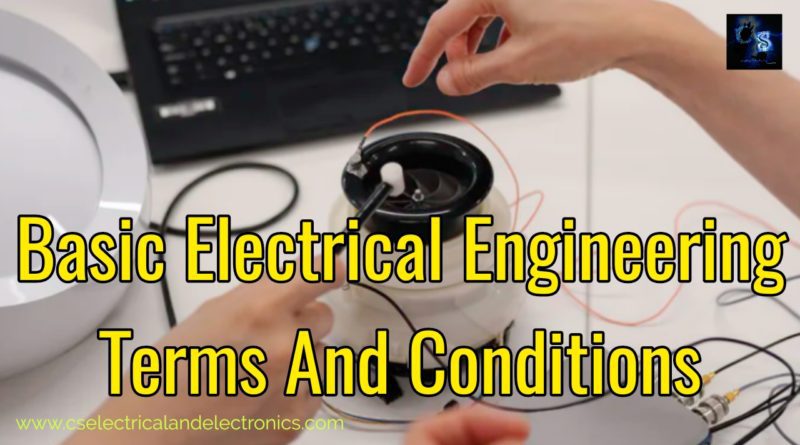Basic Electrical Engineering, Terms, Definitions, SI Unit, Formula
Hello guys, welcome back to my blog. In this article, I will discuss basic electrical engineering, terms, and definitions such as current, voltage, power, resistance, inductance, capacitance, circuit, open circuit, short circuit, time period, frequency, angular frequency, RMS value, peak factor, peak value, form factor, reluctance, rectifier, inverter, electromotive force, magnetomotive force, self-inductance, mutual inductance, etc.
If you want any article related to some other topics then comment us below in the comment box. You can also catch me @ Instagram – Chetan Shidling.
Also, read:
Basic Electrical Engineering
In this article “Basic Electrical Engineering” I will share with you basic electrical engineering terms such what is voltage, what is current, what is power, etc and their SI units with formula. If you are electrical and electronics engineering student, then you should know all basic electrical engineering terms and conditions.
01. What is a current?
Ans. Current can be defined as it is the rate of flow of charge carriers like electrons.
- S.I unit of current is ampere.
- The formula for current is,
- I = q/t……(coulomb/second = ampere).
- We can also write, I = V/R…. by OHM’S law.
02. What is a voltage?
Ans. Voltage can be defined as it is a difference in charge between two points. Or It is the pressure releasing from the power source which pushes charge carriers through a conducting glow that illuminates our light.
- S.I unit of voltage is “Voltage”.
- The formula for voltage is,
- V = IR volts. (By OHM’S law)
03. What is a power?
Ans. Power can be defined as it is the amount of work done in unit time.
- S I unit of power is “watts”.
- The formula for power is,
- P = W/t….(watts)
- Where w = work done, t = time.
04. What is resistance?
Ans. Resistance can be defined as it is the materials that oppose the flow of electrons in a particular direction.
- S I unit of resistance is “ohm”.
- The formula for resistance is,
- R = ρl /A…. ( ohm)
- Where ρ = Resistivity, A= area, l = length.
05. What is inductance?
Ans. The property of the inductor is to oppose any change in current passing through it.
S I unit is “ Henry”
06. What is capacitance?
Ans. Capacitance is a property of electrical devices, which has the ability to store an electrical charge.
- S I unit of capacitance is “Farad”.
- The formula for capacitance is,
- C = q/v…. ( coulomb/volts= farad) or
- C = εA / d … where ε= permittivity , A=area, d = perpendicular distance.
07. What is circuit?
Ans. The circuit is a combination of individual electronic components such as resistors, transistors, capacitors, inductors, and many which are connected by wires through which current flows.
08. What is open circuit>
Ans. An open circuit is an electrical circuit which will be discontinuous/ circuit is not closed, due to which the current doesn’t flow across that circuit. Or The circuit in which the two ends are free is called an open circuit. In the open circuit, the current will be zero and resistance will be infinite.
09. What is short circuit?
Ans. A short circuit is an electrical circuit in which both ends are connected that is the circuit will be closed form. In the short circuit, the resistance will be 0, and also the voltage will be 0.
10. What is closed circuit?
Ans. A closed circuit is an electrical circuit in which electrons flows.
11. What is time period?
Ans. The time period can be defined as, the time taken by the alternating quantities to complete one revolution. It will be measured in “seconds”
12. What is frequency?
Ans. Frequency can be defined as, it is a number of cycles which occurs in a second.
- S I unit of frequency is Hz.
- The formula for frequency is,
- F = 1/T…… ( Hz )
- where T= time period
13. What is angular frequency?
Ans. We can define angular frequency as, it is the number of complete oscillations that will be made in 2π units of time, during a periodic oscillatory process.
- S I unit of angular frequency is, “radians/second”.
- The formula for angular frequency is,
- ω=2π f… (rad/sec)
14. What is RMS value?
Ans. When a steady current flows through an own value of resistor for a given period of time due to which the same quantity of heat will be produced by the alternating current when it flows through the same resistor for the same time period is called RMS of alternating current. Or it is a root mean square of instantaneous values.
- RMS value of voltage is given by,
- Vrms = Vm/√2
- RMS value of current is given by,
- Irms = Im/√2
15. What is peak factor?
Ans. Peak factor can be defined as it is the ratio of maximum value to the RMS value.
- The formula for peak factor is,
- Peak factor = maximum value / r.m.s value.
16. What is peak value?
Ans. Peak value can be defined as it is the maximum value which will be attained by alternating quantity during one complete cycle.
17. What is form factor?
Ans. The form factor can be defined as it is the ratio of root mean square value to the average value of alternating quantities.
Form factor = r.m.s value / average value
18. What is reluctance?
Ans. We can define reluctance as it is the obstruction which will be offered by a magnetic circuit to the magnetic flux is termed as reluctance.
- S I unit of reluctance is, “ Ampere-turns / weber.
19. What is rectifier?
Ans. A rectifier is an electrical device, that converts alternating current into direct current. In rectifier current flows only in One Direction.
20. What is inverter?
Ans. Inverter is an electrical device which converts direct current into alternating current.
21. What is electromotive force?
Ans. Electromotive force can be defined as it is the energy that will be provided by a cell or battery per coulomb of charge that is passing through it. It is measured in terms of volts.
22. What is Magneto motive force?
Ans. This is an electrical quantity that is required to drive the magnetic plugs in a magnetic circuit. Or the magnetic pressure which will set up the magnetic flux in the magnetic circuit is called magnet or motive force.
- S I unit of MMF is, “ampere-turns”.
23. What is self inductance?
Ans. It is the induction of old age in a current-carrying conductor when they current tries to change itself in the wire due to which magnetic field will be created which will further induce voltage by itself this voltage is a self-induced voltage.
24. What is mutual inductance?
Ans. It is the phenomena in which current flowing through One coil induces a voltage in the adjacent coil.
I hope this article may help you all a lot. Thank you for reading. If you have any doubts related to this article “basic electrical engineering”, then comment below.
Tag: Basic Electrical Engineering.
Also, read:
- 10 Tips To Maintain Battery For Long Life, Battery Maintainance
- 10 Tips To Save Electricity Bills, Save Money By Saving Electricity
- 100 (AI) Artificial Intelligence Applications In The Automotive Industry
- 100 + Electrical Engineering Projects For Students, Engineers
- 1000+ Control System Quiz, Top MCQ On Control System
- 1000+ Electrical Machines Quiz, Top MCQs On Electrical Machines
- 1000+ Electronics Projects For Engineers, Diploma, MTech Students
- 1000+ MATLAB Simulink Projects For MTech, Engineering Students
- 50 Tips To Save Electricity At Home, Shop, Industry, Office
- 50+ Question And Answer On The Substation, Electrical Question
- 500+ Embedded System Projects For Engineer, Diploma, MTech, PhD
- 500+ Matlab Simulink Projects Ideas For Engineers, MTech, Diploma
- 500+ Projects For Diploma Electrical, Electronics Student, Diploma Project
- 8051 Microcontroller Timers, TCON Register, TMOD Register
- Active Cell Balancing Using A Flyback Converter Simulation In Matlab Simulink
- Advancements In 3D Printing Technology And It’s Future
- Advancements In Power Electronics For Energy Efficiency
- AI Artificial Intelligence Applications In Electric Vehicles | Future?
- AI Tools For Electronic Circuit Design, Which Is Best?
- Analog Electronics Interview Questions Most Commonly Asked
Author Profile
- Chetu
- Interest's ~ Engineering | Entrepreneurship | Politics | History | Travelling | Content Writing | Technology | Cooking
Latest entries
 All PostsApril 19, 2024What Is Vector CANoe Tool, Why It Is Used In The Automotive Industry
All PostsApril 19, 2024What Is Vector CANoe Tool, Why It Is Used In The Automotive Industry All PostsApril 13, 2024What Is TCM, Transmission Control Module, Working, Purpose,
All PostsApril 13, 2024What Is TCM, Transmission Control Module, Working, Purpose, All PostsApril 12, 2024Top 100 HiL hardware in loop Interview Questions With Answers For Engineers
All PostsApril 12, 2024Top 100 HiL hardware in loop Interview Questions With Answers For Engineers All PostsMarch 22, 2024Driver Monitoring Systems In Vehicles, Working, Driver Sleepy Alert
All PostsMarch 22, 2024Driver Monitoring Systems In Vehicles, Working, Driver Sleepy Alert








